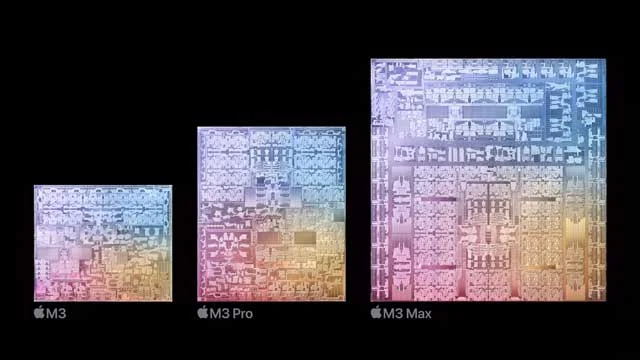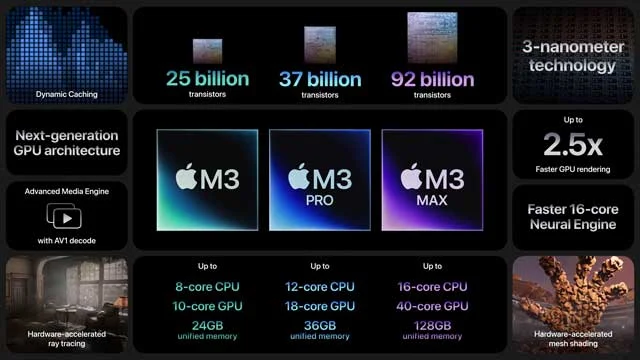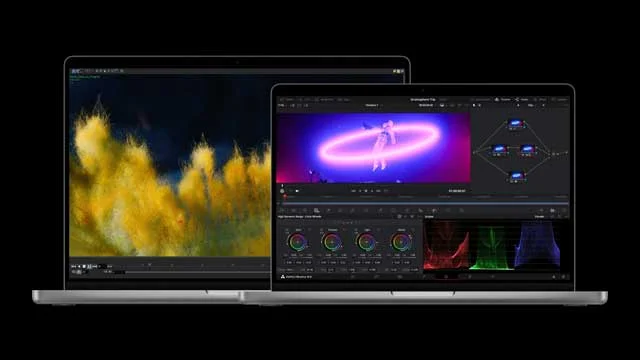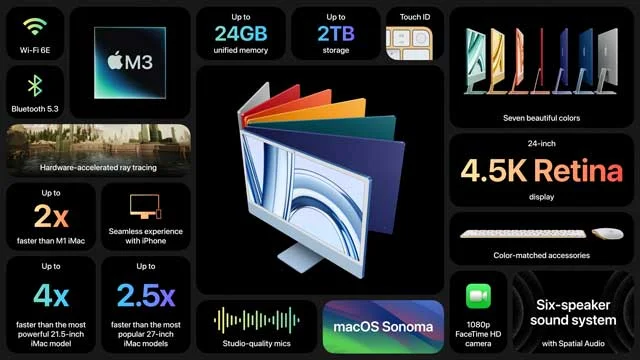Last night was the Scary Fast Apple Event. I almost forgot about it since it was at night and I didn't have high hopes for the announcements.
But I happened to see it streaming on YouTube at the beginning and decided to watch.
I was not disappointed, and likely having watched it is going to cost me money.
Here is a roundup of all the announcements, including specs on the new chips and Macs, and links to see & buy the new Macs.
Table of Contents
- M3 Chip Family: A Game-Changer For Video Pros
- Table Of M3 Chip Specs
- Additional M3 Chip Specs
- The New M3 Macbook Pros: The Ultimate Mobile Editing Suite
- Table Of M3 MacBook Pro Specs
- Additional M3 Macbook Pro Specs
- Comparison Of M1, M2, And M3 MacBook Pros
- M3 MacBook Pro Takeaways For Video Pros
- Introduction To The New M3 iMacs
- Table Of M3 iMac Specs
- Additional M3 iMac Specs
- M3 iMac Takeaways For Video Pros
- Apple Scary Fast Event / M3 Macs FAQ

M3 Chip Family: A Game-Changer for Video Pros
As a seasoned video professional, I can tell you that a powerful chip can make or break your editing experience.
Enter the M3 chip family—Apple's latest and, quite frankly, their greatest silicon to date.
This isn't just another incremental upgrade; we're talking about a monumental leap in performance and efficiency.
You know those long render times that used to make you cringe?
Consider them a thing of the past.
With up to 16 CPU cores in the M3 Max, these chips are built to handle the most demanding tasks effortlessly.
And let's not overlook the GPU capabilities—up to 32 cores that make real-time playback smoother than ever, even in 8K.
But it's not just about power; it's about smart power.
The M3 chips are finely tuned to optimize software like Final Cut Pro and Adobe Premiere, making your workflow not just faster, but also more intuitive.
Trust me, this is the kind of upgrade that makes you rethink what's possible in video editing.

Table of M3 Chip Specs
| Chip | CPU Cores | GPU Cores | Unified Memory |
|---|---|---|---|
| M3 | 8-core | 10-core | Up to 24GB |
| M3 Pro | Up to 12-core | Up to 18-core | Up to 36GB |
| M3 Max | Up to 16-core | Up to 40-core | Up to 128GB1 |
| Chip | CPU Cores | GPU Cores | Unified Memory |
Additional M3 Chip Specs
- Built on 3-nanometer technology
- Featuring an all-new GPU architecture

The New M3 MacBook Pros: The Ultimate Mobile Editing Suite
If you've been in the video editing game as long as I have, you know that portability often comes at the cost of power.
Well, Apple just shattered that notion with their new line of M3 MacBook Pros.
This is not just a laptop; it's a full-fledged mobile editing suite.
Remember those long export times that forced you to tether yourself to a desk?
With the new M3 chips, you're looking at a seismic shift in what's achievable on a laptop.
The M3 Max version, in particular, is a beast—16 CPU cores and 32 GPU cores ready to blaze through your 4K, even 8K timelines without breaking a sweat.
Battery life?
A whopping 21 hours on a single charge.
For a video editor, this translates to an entire day of shooting and editing without scouting for an outlet.
High-resolution displays with HDR capabilities mean you're not compromising on visual quality, either.
Color accuracy is top-notch, which is crucial for post-production work.
And don't even get me started on the thermal architecture; these machines stay cool under pressure, quite literally.
In short, the new M3 MacBook Pros are more than just a hardware upgrade; they're a lifeline for video pros who need to work without limits, wherever they are.
Table of M3 MacBook Pro Specs
| Model | Chip Options | Colors | Display Sizes | Ports |
|---|---|---|---|---|
| MacBook Pro 14” | M3 Pro or M3 Max | Silver, Space Black | 14.2 inches | MagSafe 3, 2x Thunderbolt 4, headphone jack, SDXC, HDMI |
| MacBook Pro 16” | M3 Pro or M3 Max | Silver, Space Black | 16.2 inches | MagSafe 3, 3x Thunderbolt 4, headphone jack, SDXC, HDMI |
Additional M3 MacBook Pro Specs
- Up to 22 hours of battery life
- World’s best laptop display
- Built-in Magic Keyboard with Touch ID and trackpad
Comparison of M1, M2, and M3 MacBook Pros
The progression from M1 to M3 in Apple's MacBook Pro lineup isn't merely iterative; it represents a transformative shift in computational capabilities.
The M1 chips were groundbreaking in their own right, offering a unified architecture that brought substantial gains in efficiency.
However, they were limited to a maximum of 8 CPU cores and 16 GB of RAM.
The introduction of the M2 chips improved upon this, providing options for higher RAM configurations and slightly enhanced CPU performance.
Yet, they were largely seen as an incremental upgrade, particularly in professional video editing contexts where power and speed are paramount.
The M3 chips are a quantum leap in this evolution.
With up to 16 CPU cores in the M3 Max variant and a staggering 128 GB RAM option, these chips are designed for intensive multitasking and high-speed data processing.
The GPU cores have also seen a substantial increment, with the M3 Max offering up to 32 cores.
This directly translates to faster rendering times, smoother playback, and more efficient use of professional video editing software.
The M3 line doesn't just set a new standard; it redefines what video editors can expect from a portable workstation.
The capabilities now available to MacBook Pro users bridge the gap between mobile and desktop computing, setting a new precedent in the industry.
M3 MacBook Pro Takeaways for Video Pros
What does this mean for you as a video pro?
Faster rendering, efficient multitasking, and less lag.
The M3 MacBook Pros are designed to handle everything you throw at them.
I currently do my video editing, color grading, and animation work on an M1 Max MacBook Pro and I will be looking into upgrading soon, especially with a trade-in option.

Introduction to the New M3 iMacs
For video editors who require more screen real estate and computational power, the new M3 iMacs stand as a great example to what desktop computing can offer.
While laptops like the MacBook Pro provide excellent portability, there are instances where the larger canvas of a desktop display is indispensable for intricate editing tasks.
The M3 iMacs arrive with up to 27-inch Retina displays, offering unparalleled color accuracy and sharpness.
These are not mere displays; they are calibrated canvases designed for professionals who need to scrutinize every pixel.
These iMacs come with a suite of ports that offer extensive connectivity options, something that is often a pain point for video editors.
And let's not forget the design—the slim form factor and color options make it a stylish addition to any workspace.
In summary, the new M3 iMacs are not just an upgrade; they are a reimagining of what a desktop can be for video editing professionals.
With their blend of performance, display quality, and design, they offer a compelling alternative to even high-end workstations.

Table of M3 iMac Specs
| Feature | Specification | |
|---|---|---|
| Chip | Apple M3 | |
| CPU | 8-core (4 performance cores and 4 efficiency cores) | |
| GPU | Up to 10-core | |
| Unified Memory | Up to 24GB | |
| Storage | Up to 2TB | |
| Display | 24-inch 4.5K Retina | |
| Camera | 1080p FaceTime HD | |
| Colors | Blue, Green, Pink, Silver, Yellow, Orange, Purple |
Additional M3 iMac Specs
- Hardware-accelerated ray tracing
- 16-core Neural Engine
- 100GB/s memory bandwidth
- Media Engine: Hardware-accelerated H.264, HEVC, ProRes, and ProRes RAW, Video decode engine, Video encode engine, ProRes encode and decode engine, AV1 decode
- Display Support: One external display with up to 6K resolution at 60Hz
- Magic Keyboard with Touch ID
M3 iMac Takeaways for Video Pros
The new M3 iMacs offer a perfect blend of power and screen real estate.
Whether you're editing a short film or a feature-length documentary, these machines won't let you down.
Apple Scary Fast Event / M3 Macs FAQ
What was Announced at the Scary Fast Apple Event?
Apple announced a new lineup of products featuring the powerful M3 chip family. This includes new MacBook Pros, iMacs, and a special black edition of the MacBook Pro.
What are the Specs of the M3 Chips?
The M3 chip family includes M3 Base, M3 Pro, and M3 Max. They vary in terms of CPU cores, GPU cores, RAM, and storage options. Please refer to the "Table of M3 Chip Specs" section for detailed information.
What are the Specs of the M3 iMacs?
The new M3 iMacs come in 24-inch and 27-inch sizes, featuring the M3 Pro and M3 Max chips. They offer up to 128 GB of RAM and 2 TB of storage. For more details, check the "Table of M3 iMac Specs" section.
What are the Specs of the M3 MacBook Pro?
The new M3 MacBook Pros are available in 14-inch and 16-inch sizes. They feature the M3 Pro and M3 Max chips, with up to 128 GB of RAM and 2 TB of storage. More details can be found in the "Table of M3 MacBook Pro Specs" section.
What are the Colors of the M3 iMac?
The new M3 iMacs come in a range of colors, including silver, space gray, and rose gold.
Should I Upgrade from my M1 MacBook Pro?
If you're a video editor looking for faster rendering and more efficient multitasking, upgrading to an M3 MacBook Pro could be beneficial. The new chips offer a significant performance boost over the M1.
Should I Upgrade from my Intel MacBook Pro?
The new M3 chips offer better performance and efficiency compared to Intel chips. If you're using resource-intensive software for video editing, an upgrade could dramatically improve your workflow.
Should I Upgrade from my iMac?
If your current iMac struggles with your video editing tasks, the new M3 iMacs offer a compelling reason to upgrade. They provide more power and larger displays, enhancing your editing experience.

About the Author
Joseph Nilo has been working professionally in all aspects of audio and video production for over twenty years. His day-to-day work finds him working as a video editor, 2D and 3D motion graphics designer, voiceover artist and audio engineer, and colorist for corporate projects and feature films.
Video Editing Related Posts
Adobe Creative Cloud for Video Editing
Top 10 Video Editing Software for Mac
The Benefits of Dual-Monitor Setups for Video Editing
How to Choose the Right Video Editing Monitor for Your Needs
Best Monitors for Video Editing
Best Video Editing Software in 2023
Best Mac for Video Editing in 2023
(Almost) 50 Mistakes Every New Video Producer Makes
Breakthrough AI Tools: Elevate Your Video Production Game!
- M3 Chip Family: A Game-Changer For Video Pros
- Table Of M3 Chip Specs
- Additional M3 Chip Specs
- The New M3 Macbook Pros: The Ultimate Mobile Editing Suite
- Table Of M3 MacBook Pro Specs
- Additional M3 Macbook Pro Specs
- Comparison Of M1, M2, And M3 MacBook Pros
- M3 MacBook Pro Takeaways For Video Pros
- Introduction To The New M3 iMacs
- Table Of M3 iMac Specs
- Additional M3 iMac Specs
- M3 iMac Takeaways For Video Pros
- Apple Scary Fast Event / M3 Macs FAQ
Video Editing Related Posts
Adobe Creative Cloud for Video Editing
Top 10 Video Editing Software for Mac
The Benefits of Dual-Monitor Setups for Video Editing
How to Choose the Right Video Editing Monitor for Your Needs
Best Monitors for Video Editing
Best Video Editing Software in 2023
Best Mac for Video Editing in 2023
(Almost) 50 Mistakes Every New Video Producer Makes
Breakthrough AI Tools: Elevate Your Video Production Game!
